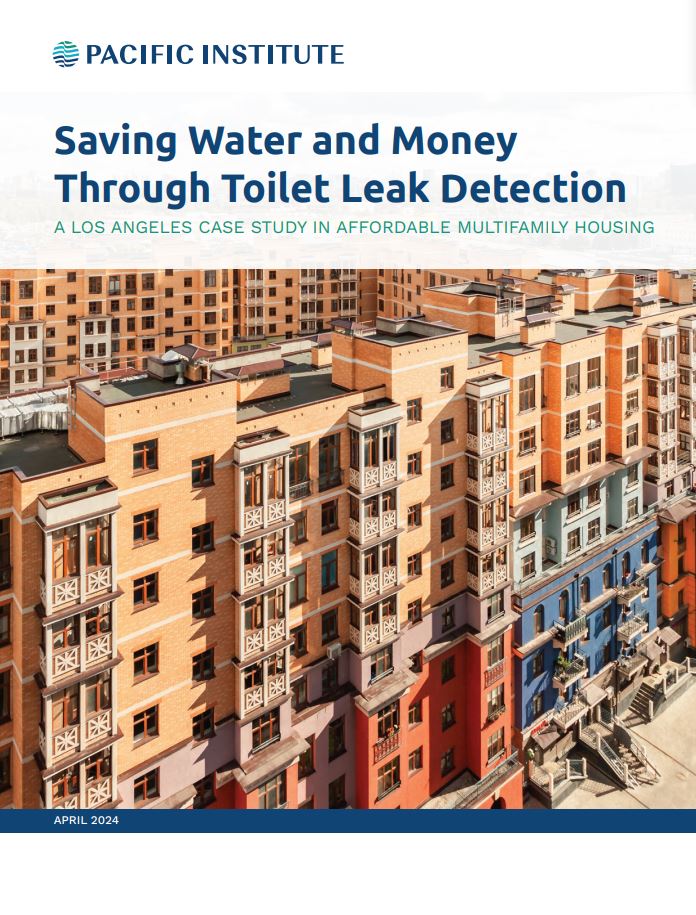Saving Water and Money Through Toilet Leak Detection: A Los Angeles Case Study in Affordable Multifamily Housing

Saving Water and Money Through Toilet Leak Detection: A Los Angeles Case Study in Affordable Multifamily Housing
Overview
New Pacific Institute research finds toilet leak detection can offer significant water and cost savings at multifamily housing buildings, addressing a critical yet overlooked aspect of urban water efficiency.
Toilets are often the main source of water use in the home, accounting for nearly 30% of indoor water consumption. But every year, household leaks waste nearly 1 trillion gallons of water across the United States (US Environmental Protection Agency, 2024). These leaks are particularly hard to detect and address in large multifamily apartment buildings.
In response, a Pacific Institute pilot project in Los Angeles investigated these challenges in eight multifamily affordable housing properties, deploying advanced toilet leak detection technology. This initiative, detailed in the report, explored the impact of installing 1,198 leak sensors across properties managed by the Housing Authority of the City of Los Angeles (HACLA) within the Los Angeles Department of Water and Power (LADWP) service area.
The report finds significant water and cost savings from deploying toilet leak detection technology in these properties. It reveals that 51% of toilet water was lost to leaks even after leak detection was implemented. These findings are not just numbers; they represent a substantial impact on water efficiency and affordability. Through proactive leak management, the pilot project achieved an 11% reduction in water use and a 12% reduction in water and wastewater bill costs. Annually, this translates to estimated annual savings of 3,469 gallons of water and $81 in costs for each toilet sensor installed.
Key Learnings & Recommendations
Deploying toilet leak detection technology in Los Angeles’s affordable multifamily properties has revealed significant water and cost savings potential. This underscores the necessity of expanding such initiatives. Key learnings and recommendations to guide future initiatives include:
Engagement with Property Management Is Critical
- Learning: Sustained and direct interaction with property management staff is crucial for maximizing long-term water savings.
- Recommendation: Establish a comprehensive engagement strategy that ensures property staff are consistently and effectively using the technology.
Overcoming Data Limitations in Master-Metered Properties
- Learning: Evaluating the impact of interventions in master-metered properties is impeded by data limitations.
- Recommendation: Implement a baseline data collection phase with leak sensors before alert activation to accurately measure water savings.
Leveraging Corporate Water Stewardship for Innovation
- Learning: Investments from corporate water stewardship can spearhead innovative solutions in collaborative water projects.
- Recommendation: Pursue co-funding opportunities from corporations, facilitated by intermediaries, for projects demonstrating quantifiable water benefits.
Engaging Residents in Water Conservation Efforts
- Learning: Residents in multifamily housing are often excluded from participating in and benefiting from water conservation projects.
- Recommendation: Proactively incorporate residents into the project through education and engagement initiatives, ensuring they benefit from water savings.
Recommendations for Scaling
As water scarcity worsens and water costs continue to rise in Southern California, and many other places around the United States and globally, it is critical to invest in innovative opportunities to reduce water waste and improve water resilience. The report explores how water efficiency solutions, including toilet leak detection, could be expanded in multifamily housing. It also provides these two specific recommendations for scaling, with specific strategies and examples supporting each.
Expand existing water and energy conservation incentive programs
- Incorporate water into energy efficiency programs for multifamily housing
- Incorporate solutions for multifamily properties into water conservation incentive programs
- Incorporate performance-based incentives into water conservation incentive programs
Develop innovative financing solutions
- Offer on-bill financing for water efficiency projects
- Set up revolving funds to a sustainable source of capital for water efficiency projects

